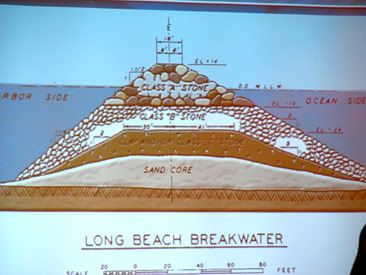
The City of Long Beach and engineering firm Moffatt & Nichol teamed up to host an information session and community forum meeting about the city’s oldest conundrum: the breakwater. It was the first of three informational meetings designed to keep the public up-to-date on Moffatt & Nichol’s progress since being awarded a contract from the City to determine the best course of action for the underwater structure.
(Click here to download the Powerpoint presentation and view it for yourself!)
No definite plan of action was displayed, but the firm showed many important findings and posed serious questions that will influence their final decision. Ranging from a complete destruction to structural tinkering, Moffatt & Nichol has been busy testing the effects of any alteration to the breakwater.

The breakwater is 16 feet wide on the surface, but 150 feet wide on the ocean floor.
One graph showed the forces of wave energy currently reaching Long Beach’s shores, and the forces of waves that would hit the beaches if the breakwater were removed. The new wave forces were obviously stronger, but it is not known yet whether this change would increase erosion or actually increase beach buildup. The city’s beaches have eroded heavily since the arrival of the breakwater, and many believe that removing the breakwater would allow waves to carry sand to shore and greatly improve local beaches – alleviating concerns of peninsula residents who fear that removing the protection of the breakwater would endanger their beachfront homes.
Another study showed the route of a theoretical piece of trash as it travels down the L.A. River and enters the Long Beach harbor. With the breakwater, the trash sticks to Long Beach shores and travels along the city’s beaches all the way down the peninsula. Without the breakwater, the trash turns tail and makes a dash for open water – a clear indication that removing (or altering) the breakwater has potential to improve circulation and water quality conditions.

Moffatt & Nichol engineer Russ Boudreau presents the firm’s findings thus far.
The crowd boasted many familiar faces – from City Councilwoman Rae Gabelich to Long Beach Surfrider spokesperson Robert Palmer, Smooth’s Sports Grille owner John Morris and retired engineer Bud Johnson, who penned a massive breakwater study and recommendation on his own time that has received intense attention from City Council, the Harbor Commission and even Moffatt & Nichol.
“I have a lot of confidence in [Moffatt & Nichol],” Johnson said. “They’re the right group for this. We need this kind of study, and we’ve gotta have public input. I feel good, because we started with just our report and the goal was to get all th way to Moffatt & Nichol. It shows that you can do it – one person can have a difference. Not that I will, but I have the chance.”
Every resident has the chance to participate in the next two study sessions:
Wednesday, October 29, 2008
6:30 – 8:30 p.m.
Long Beach Gas & Oil
2400 E. Spring Street
Long Beach, CA 90806
Wednesday, November 19, 2008
6:30 – 8:30 p.m.
Long Beach Aquarium of the Pacific
100 Aquarium Way
Long Beach, CA 90802

Boudreau presents a slide showing current wave energy (top), and potential wave energy if the breakwater is removed (bottom).
By Ryan ZumMallen, Managing Editor
